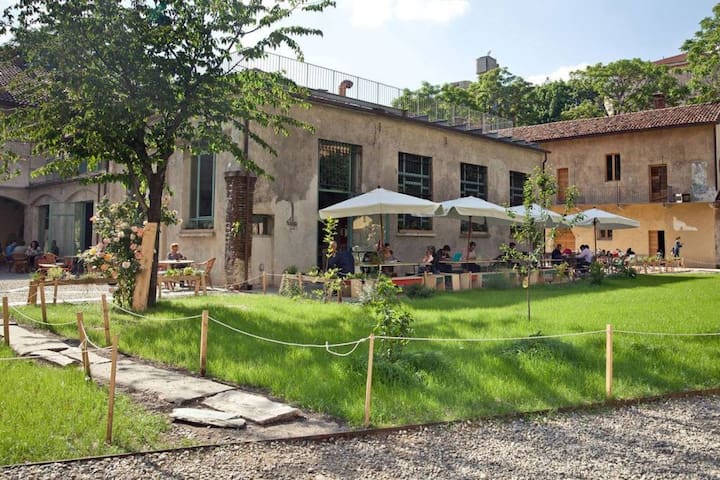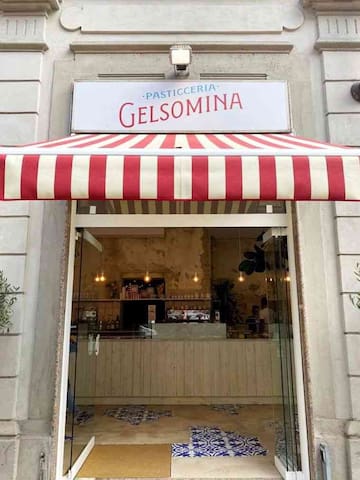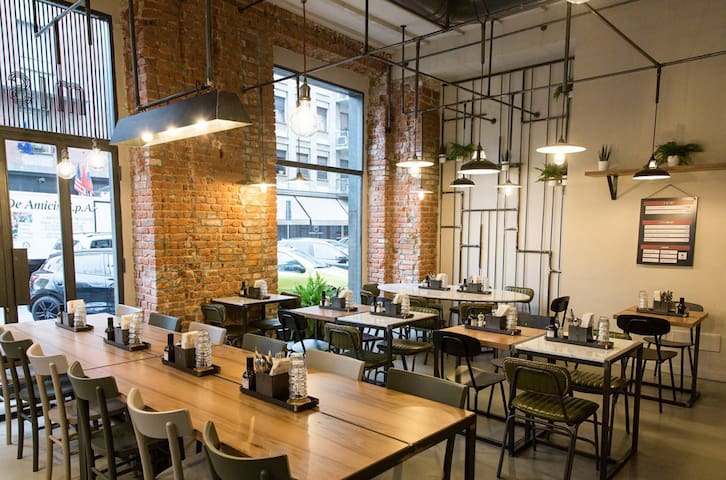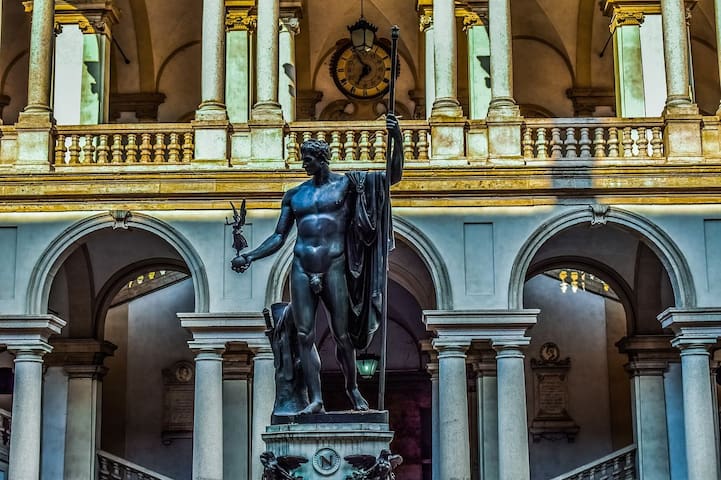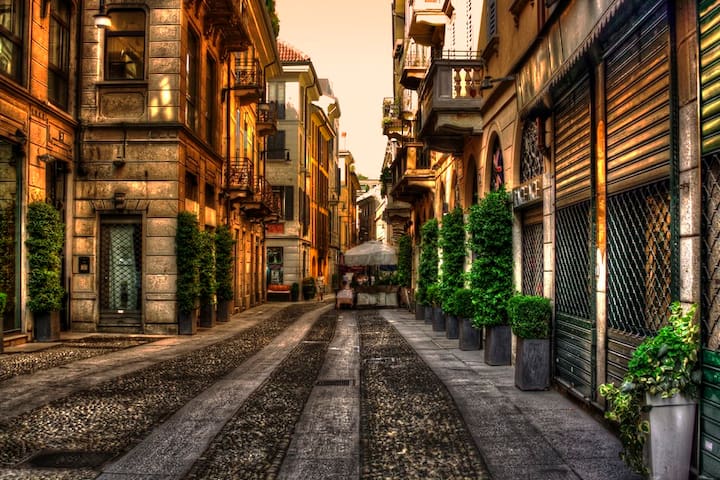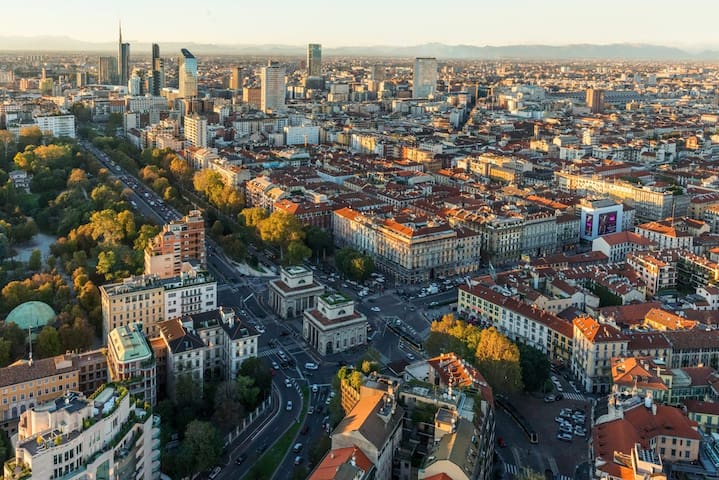Food Nearby
I Mori milano
5 Via ArchimedeHigh sicilian food
Here you can make an excellent aperitif or have dinner; the location is beautiful and unusual for an urban center like Milan: it is in fact a real rural farmhouse.
medium prices
69 personas locales recomiendan
Un Posto a Milano
2/4 Via Privata CuccagnaHere you can make an excellent aperitif or have dinner; the location is beautiful and unusual for an urban center like Milan: it is in fact a real rural farmhouse.
medium prices
La Cozzeria
34 Via Lodovico MuratoriSpecialties of mussels and fish: absolutely to try.
Gelsomina
2 Via Galvano FiammaExcellent pastry chef, to try the Roman Maritozzo.
Miscusi
6 Via Pompeo LittaTraditional Italian pasta factory
medium prices
Various corner foods: bakery, pastry, vegetarian food, fish and meat
Average prices
30 personas locales recomiendan
Mercato del suffragio
Corso Ventidue MarzoVarious corner foods: bakery, pastry, vegetarian food, fish and meat
Average prices
Pizzium - Via Anfossi
1 Via Augusto AnfossiTypical Neapolitan high pizza
Crocca
4 Via Galvano FiammaOur favorite pizza, digestible and crunchy.
Crocca
Thin, crunchy and delicious pizza: our favourite. Excellent value for money
Arts & Culture
Museums and locations of artistic and cultural interest
The Museo of Novecento, located inside the Palazzo dell’Arengario in Piazza del Duomo, hosts a collection of over four thousand works that catalyze the development of 20th century Italian art.
Established and developed thanks to the generosity of Milanese private collectors and philanthropists, the Collection of the Museo del Novecento is one of the important 20th century Italian art selections. The exhibition gathers approximately 400 works displayed in chronological order. The initial date is 1902, the year of the Quarto Stato (The Fourth Estate) by Giuseppe Pellizza da Volpedo
The Collection then begins with a tribute paid to international avant-garde movements, with paintings from the early 1900’s by Pablo Picasso, Georges Braque, Paul Klee, Kandinsky, and Amedeo Modigliani. The exhibition continues with Futurism, represented by a nucleus of artwork unique the world over, displaying Umberto Boccioni, Giacomo Balla, Fortunato Depero, Gino Severini, Carlo Carrà, and Ardengo Soffici. The Twenties and Thirties, moving between the Novecento movement and Abstract Art, develop through a sequence of solo art show ‘islands’ devoted to Giorgio de Chirico, Giorgio Morandi, Arturo Martini, and Fausto Melotti. To Marino Marini is devoted a proper hall, aimed to describe the artist's rich and nuanced production.
The top floor of the Palazzo dell’Arengario is devoted entirely to Lucio Fontana.
_________________________
Il Museo del Novecento, all’interno del Palazzo dell’Arengario in piazza del Duomo, ospita una collezione di oltre quattromila opere di arte italiana del XX secolo.
Nata grazie alla generosità e alla passione dei collezionisti milanesi, la Collezione del Museo del Novecento è una tra le più importanti raccolte d’arte italiana del XX secolo. Il percorso espositivo raccoglie circa 400 opere, allestite secondo un criterio cronologico. Data di partenza: 1902, l’anno di esposizione del Quarto Stato di Giuseppe Pellizza da Volpedo.
La Collezione prende avvio con un omaggio alle Avanguardie Internazionali, con dipinti d’inizio secolo di Pablo Picasso, Georges Braque, Paul Klee, Vasilij Kandinskij e Amedeo Modigliani. L’allestimento prosegue con il Futurismo, rappresentato da un nucleo di opere unico al mondo, con Umberto Boccioni, Giacomo Balla, Fortunato Depero, Gino Severini, Carlo Carrà, Ardengo Soffici. Gli anni Venti e Trenta, tra Novecento e Astrattismo, si sviluppano e completano attraverso una sequenza di “isole” monografiche dedicate a Giorgio de Chirico, Giorgio Morandi, Arturo Martini e Fausto Melotti. A Marino Marini è destinato uno spazio proprio, che mira a fornire uno scorcio della ricca e variegata produzione dell'artista.
A Lucio Fontana è dedicato l’intero ultimo piano dell’Arengario.
585 personas locales recomiendan
Museo del Novecento
8 P.za del DuomoThe Museo of Novecento, located inside the Palazzo dell’Arengario in Piazza del Duomo, hosts a collection of over four thousand works that catalyze the development of 20th century Italian art.
Established and developed thanks to the generosity of Milanese private collectors and philanthropists, the Collection of the Museo del Novecento is one of the important 20th century Italian art selections. The exhibition gathers approximately 400 works displayed in chronological order. The initial date is 1902, the year of the Quarto Stato (The Fourth Estate) by Giuseppe Pellizza da Volpedo
The Collection then begins with a tribute paid to international avant-garde movements, with paintings from the early 1900’s by Pablo Picasso, Georges Braque, Paul Klee, Kandinsky, and Amedeo Modigliani. The exhibition continues with Futurism, represented by a nucleus of artwork unique the world over, displaying Umberto Boccioni, Giacomo Balla, Fortunato Depero, Gino Severini, Carlo Carrà, and Ardengo Soffici. The Twenties and Thirties, moving between the Novecento movement and Abstract Art, develop through a sequence of solo art show ‘islands’ devoted to Giorgio de Chirico, Giorgio Morandi, Arturo Martini, and Fausto Melotti. To Marino Marini is devoted a proper hall, aimed to describe the artist's rich and nuanced production.
The top floor of the Palazzo dell’Arengario is devoted entirely to Lucio Fontana.
_________________________
Il Museo del Novecento, all’interno del Palazzo dell’Arengario in piazza del Duomo, ospita una collezione di oltre quattromila opere di arte italiana del XX secolo.
Nata grazie alla generosità e alla passione dei collezionisti milanesi, la Collezione del Museo del Novecento è una tra le più importanti raccolte d’arte italiana del XX secolo. Il percorso espositivo raccoglie circa 400 opere, allestite secondo un criterio cronologico. Data di partenza: 1902, l’anno di esposizione del Quarto Stato di Giuseppe Pellizza da Volpedo.
La Collezione prende avvio con un omaggio alle Avanguardie Internazionali, con dipinti d’inizio secolo di Pablo Picasso, Georges Braque, Paul Klee, Vasilij Kandinskij e Amedeo Modigliani. L’allestimento prosegue con il Futurismo, rappresentato da un nucleo di opere unico al mondo, con Umberto Boccioni, Giacomo Balla, Fortunato Depero, Gino Severini, Carlo Carrà, Ardengo Soffici. Gli anni Venti e Trenta, tra Novecento e Astrattismo, si sviluppano e completano attraverso una sequenza di “isole” monografiche dedicate a Giorgio de Chirico, Giorgio Morandi, Arturo Martini e Fausto Melotti. A Marino Marini è destinato uno spazio proprio, che mira a fornire uno scorcio della ricca e variegata produzione dell'artista.
A Lucio Fontana è dedicato l’intero ultimo piano dell’Arengario.
The collection of the Pinacoteca di Brera includes some of the greatest masterpieces of Italian and foreign art from the 13th to the 20th century. The works are displayed on the first floor of the building, where the Academy of Fine Arts is also located.
The Pinacoteca museum, which opened in 1809 thanks to Napoleon Bonaparte, was born as a collection of the finest works of art and was dedicated to the education of students. The collection included Italian art masterpieces taken from churches and monasteries that were suppressed at the time when Milan was the capital city of the Kingdom of Italy.
Unlike other great Italian museums, the Pinacoteca di Brera was not founded thanks to private collections belonging to monarchs or noble families, but through a political action by the state. The collection has subsequently been enlarged through exchanges, acquisitions and donations.
______________________________
La Pinacoteca di Brera venne ufficialmente istituita nel 1809, raccoglie capolavori dell’arte italiana e straniera dal XIII al XX secolo, allestiti al piano nobile dell’omonimo palazzo, sede anche dell’Accademia di Belle Arti.
Il museo nasce per volontà di Napoleone Bonaparte, come raccolta di opere esemplari da destinarsi alla formazione degli studenti, che radunasse capolavori di pittura italiana, prelevati da chiese e conventi soppressi negli anni di Milano capitale del Regno Italico.
A differenza di altri grandi musei italiani Brera non ha origine dal collezionismo privato di regnanti e famiglie nobili ma da un’iniziativa politica di stato. Le collezioni si sono arricchite negli anni attraverso scambi, acquisti e donazioni.
782 personas locales recomiendan
Pinacoteca di Brera
28 Via BreraThe collection of the Pinacoteca di Brera includes some of the greatest masterpieces of Italian and foreign art from the 13th to the 20th century. The works are displayed on the first floor of the building, where the Academy of Fine Arts is also located.
The Pinacoteca museum, which opened in 1809 thanks to Napoleon Bonaparte, was born as a collection of the finest works of art and was dedicated to the education of students. The collection included Italian art masterpieces taken from churches and monasteries that were suppressed at the time when Milan was the capital city of the Kingdom of Italy.
Unlike other great Italian museums, the Pinacoteca di Brera was not founded thanks to private collections belonging to monarchs or noble families, but through a political action by the state. The collection has subsequently been enlarged through exchanges, acquisitions and donations.
______________________________
La Pinacoteca di Brera venne ufficialmente istituita nel 1809, raccoglie capolavori dell’arte italiana e straniera dal XIII al XX secolo, allestiti al piano nobile dell’omonimo palazzo, sede anche dell’Accademia di Belle Arti.
Il museo nasce per volontà di Napoleone Bonaparte, come raccolta di opere esemplari da destinarsi alla formazione degli studenti, che radunasse capolavori di pittura italiana, prelevati da chiese e conventi soppressi negli anni di Milano capitale del Regno Italico.
A differenza di altri grandi musei italiani Brera non ha origine dal collezionismo privato di regnanti e famiglie nobili ma da un’iniziativa politica di stato. Le collezioni si sono arricchite negli anni attraverso scambi, acquisti e donazioni.
La Triennale di Milano is an international cultural institution that produces exhibitions, conferences and events in art, design, architecture, fashion, cinema, communication and society. It organizes exhibitions dedicated to contemporary art, to architects and designers of national and international renown, to the great designers who have changed taste and customs, to social themes.
_____________________
La Triennale di Milano è un’istituzione culturale internazionale che produce mostre, convegni ed eventi di arte, design, architettura, moda, cinema, comunicazione e società. Organizza mostre dedicate all’arte contemporanea, agli architetti e designer di fama nazionale e internazionale, ai grandi stilisti che hanno cambiato il gusto e il costume, ai temi sociali.
353 personas locales recomiendan
La Triennale di Milano
6 Viale Emilio AlemagnaLa Triennale di Milano is an international cultural institution that produces exhibitions, conferences and events in art, design, architecture, fashion, cinema, communication and society. It organizes exhibitions dedicated to contemporary art, to architects and designers of national and international renown, to the great designers who have changed taste and customs, to social themes.
_____________________
La Triennale di Milano è un’istituzione culturale internazionale che produce mostre, convegni ed eventi di arte, design, architettura, moda, cinema, comunicazione e società. Organizza mostre dedicate all’arte contemporanea, agli architetti e designer di fama nazionale e internazionale, ai grandi stilisti che hanno cambiato il gusto e il costume, ai temi sociali.
Gallerie d'Italia is the set of exhibition spaces created by Intesa Sanpaolo to make its artistic and architectural heritage available, together with the collections from the Cariplo Foundation in Milan, another partner of the project.
_________________________
Gallerie d'Italia è l'insieme degli spazi espositivi realizzati da Intesa Sanpaolo per rendere disponibile il proprio patrimonio artistico e architettonico, insieme alle collezioni provenienti dalla Fondazione Cariplo di Milano, altro partner del progetto
84 personas locales recomiendan
Gallerie d'Italia
6 Piazza della ScalaGallerie d'Italia is the set of exhibition spaces created by Intesa Sanpaolo to make its artistic and architectural heritage available, together with the collections from the Cariplo Foundation in Milan, another partner of the project.
_________________________
Gallerie d'Italia è l'insieme degli spazi espositivi realizzati da Intesa Sanpaolo per rendere disponibile il proprio patrimonio artistico e architettonico, insieme alle collezioni provenienti dalla Fondazione Cariplo di Milano, altro partner del progetto
Villa Reale in Milan
16 Via PalestroInaugurated in 2015, the Prada Foundation is located in an industrial complex dating back to 1910, a former gin distillery in Largo Isarco, a southern suburb of Milan. Suggestive location where the coexistence of new and regenerated buildings including warehouses, laboratories and production silos, as well as new buildings coexist beautifully.
548 personas locales recomiendan
Fondazione Prada
10 Via Giovanni LorenziniInaugurated in 2015, the Prada Foundation is located in an industrial complex dating back to 1910, a former gin distillery in Largo Isarco, a southern suburb of Milan. Suggestive location where the coexistence of new and regenerated buildings including warehouses, laboratories and production silos, as well as new buildings coexist beautifully.
District guide
Brera is the most characteristic district of the city; the narrow streets all pedestrian and the many bars and restaurants make it a romantic and carefree place.
756 personas locales recomiendan
Brera
Brera is the most characteristic district of the city; the narrow streets all pedestrian and the many bars and restaurants make it a romantic and carefree place.
Porta Venezia is a neighborhood that offers everything you could wish for: full of unique and irresistible clubs, fashionable shops, historic art galleries, museums and the liberty architecture of its marvelous buildings.
At Porta Venezia you can find all kinds of food, with the highest concentration of restaurants from all over the world; it is a welcoming neighborhood full of life not only during the day, but also at night.
Shopping at Porta Venezia is a fascinating experience that will surprise you. On the sides of Corso Buenos Aires, get ready to see something extraordinary: here you will find refined and emerging fashion boutiques.
www.portaveneziasocial.com/
284 personas locales recomiendan
Porta Venezia
1 Bastioni di Porta VeneziaPorta Venezia is a neighborhood that offers everything you could wish for: full of unique and irresistible clubs, fashionable shops, historic art galleries, museums and the liberty architecture of its marvelous buildings.
At Porta Venezia you can find all kinds of food, with the highest concentration of restaurants from all over the world; it is a welcoming neighborhood full of life not only during the day, but also at night.
Shopping at Porta Venezia is a fascinating experience that will surprise you. On the sides of Corso Buenos Aires, get ready to see something extraordinary: here you will find refined and emerging fashion boutiques.
www.portaveneziasocial.com/
Fashion district
Milan is the capital of Italian and international fashion: numerous jewelers, design and furnishing boutiques, and many ateliers of the most important brands in the so-called "Fashion Quadrilateral".
So called because it is bordered by four streets - Via Monte Napoleone, Via Alessandro Manzoni, Via della Spiga and Corso Venezia - the "Quadrilatero della moda" is the district where the best fashion designers offer their extraordinary creations.
To buy in showrooms and boutiques in these streets, or just to admire the shop windows, shoppers come from all over the world.
Walking around the Quadrilatero is a unique opportunity for tourists to breathe the magical atmosphere of Milan among the lights of the shops, the elegance of the ateliers, the colorful shop windows, the charm of the perfumeries, surrounded by the best brands in the world: Armani, Versace , Alberta Ferretti, Dolce and Gabbana, Prada, Fendi, Louis Vuitton, Chanel, Bottega Veneta, Gucci, Bulgari, Cartier, Valentino, Balenciaga and Ferrè.
The heart of the neighborhood is via Monte Napoleone, considered one of the most expensive and prestigious streets in the world on a par with Fifth Avenue in New York and the Avenue des Champs Elysees in Paris.
175 personas locales recomiendan
Quadrilatero d'Oro
10 Via Monte NapoleoneFashion district
Milan is the capital of Italian and international fashion: numerous jewelers, design and furnishing boutiques, and many ateliers of the most important brands in the so-called "Fashion Quadrilateral".
So called because it is bordered by four streets - Via Monte Napoleone, Via Alessandro Manzoni, Via della Spiga and Corso Venezia - the "Quadrilatero della moda" is the district where the best fashion designers offer their extraordinary creations.
To buy in showrooms and boutiques in these streets, or just to admire the shop windows, shoppers come from all over the world.
Walking around the Quadrilatero is a unique opportunity for tourists to breathe the magical atmosphere of Milan among the lights of the shops, the elegance of the ateliers, the colorful shop windows, the charm of the perfumeries, surrounded by the best brands in the world: Armani, Versace , Alberta Ferretti, Dolce and Gabbana, Prada, Fendi, Louis Vuitton, Chanel, Bottega Veneta, Gucci, Bulgari, Cartier, Valentino, Balenciaga and Ferrè.
The heart of the neighborhood is via Monte Napoleone, considered one of the most expensive and prestigious streets in the world on a par with Fifth Avenue in New York and the Avenue des Champs Elysees in Paris.

